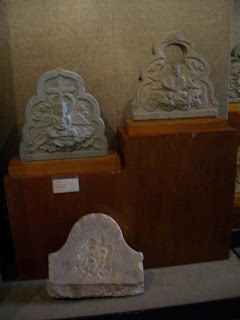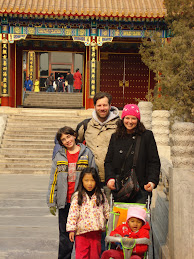
Today we headed off on a long anticipated day trip to Quanzhou (pronounced qwin-djoe), which is about 90 km north of Xiamen along the coast. For hundreds of years beginning around 1100 AD, this area was the most important port for trade in the world, and the start of the "Silk Road of the Sea" the source of much of the silk and tea shipped from China around the world. Two fun facts according to my guidebook -- Columbus was looking for Quanzhou when he discovered America...and the tea sunk in Boston Harbor at the Boston Tea party was on a ship whose original port of call was Quanzhou. There were people from all over the world living in Quanzhou in the early days, and we got some ideas about that as we toured some important sites with Michael's student, Guo Jinjie..a PhD student in philosophy who is our good friend. It was a whirlwind tour of 3 temples, a stone statue and a museum -- all in one day!
We began at the local temple to Mazu, the Goddess of the sea, worshiped only in Fujian, Guangzhou and Taiwan. Mazu was a real person who attained the statues of a deity due to her piety, and has been worshiped especially by sailors and fishermen. The temple was interesting to me because of all the ocean motifs..sea horses, sea dragons and such...


Her altar was very colorful, and Helen was very interested and had us burn some incense like other people were doing.

Mazu worship is not part of Buddusim or other major religion, just a local deity with a number of temples...having a tree altar to highlight the divine nature of the tree is also still common in some places..

We set off to walk along the main street (named Zhongshan Road of course, like nearly all main streets in China, after Dr. Sun Yatsen). Michael snapped a photo of this quaint barber shop (although it evoked Sweeney Todd for me...)


At the Confucian temple nearby, there was a museum showing a replica of a parade of successful scholars. Remember Michael went to Qufu, the birthplace of Kong Zi (Confucius) a few weeks ago? This is a very old temple dedicated to him,Fu Wen Miao, built around 900 AD. In the system Confucius helped establish, everyone was able to participate in examinations, and the best students, regardless of family background, were given the best posts in the government. Of course it was easier for wealthy young men to do well, since they had tutors and free time for study, but the notion that anyone could study hard and achieve some position in life was a truly revolutionary one in its time. Some temple drums...


My best attempt to sneak a photo, although there was a sign, I turned off my flash and was stealthy...

Outside Guo showed us hundreds of maobi (calligraphy brushes) left by students who had some to pray for success in their studies..

May of them had some fervent notes attached...

We did take a "kid break" from the temple world for a few minutes at the carnival on the plaza by the temple and some lunch. then it was tie for the Buddhists, and the Kaiyuan temple with its graceful pagodas...


And its ancient trees -- this one a mere 800 years old was the most impressive, but the 1200 year old tree looked like it might be shrinking...can you imagine? This tree was a sapling in the time of Charlemagne...amazing!


Thomas gives me a good thoughtful pose..."if you aren't a little bit intellectual, this would be boring..." Question:"ARE you bored?" Reply: "no, not really...."

Note the monk on the cell phone above..
Now, I live next door to a Buddhist temple. And I regularly see monks playing basketball, grocery shopping and even talking on cell phones. BUT I have never seen one do it while about to step over the threshold into the temple proper -- that was a first. And a minute later he was telling me -- "no photos" but I got one in anyway...the images all have different hand positions which represent mini"sermons". There were may Buddhist images here -- quite impressive.


The architecture of the city reveals a bit about its past. Quanzhou was a very Arabic city in ancient times, and there is a thriving Muslim community today. At the height of Quanzhou's importance, around 1000- 1300 AD, there were many Arabic people, some even in positions of leadership in the city, and all of the world's major religions (and a few minor ones) were allowed to flourish and coexisted peacefully. The Song dynasty emperors even gave some religious leaders a salary for their work, like the court philosophers and priests would receive.

In the museum of world religions adjoining the Maritime museum, we saw dozens of ancient stone grave markers which have been excavated in Quanzhou over the years..do you see the combination of Chinese and Arabic on this one?
Here are the Christian ones..
.

Andrew of Perugia was based here, and there were also Nestorian Christians, Hindus and even the last remaining center for worship of the prophet Mani (below) -- a Persian from the 4th Century who taught that all religions contain some truth and lead on the path to "Light." St. Augustine followed Manichaean worship until his conversion. Some of the followers of Mani came to Quanzhou to escape persecution and established a nunnery which is the last know place on Earth where he is worshipped. Unfortunately it was too far for us to see it today.

...Because we were headed to see SHIPS at the maritime museum. There were hundreds of historically accurate models, and I gave Thomas the camera, so I now have a photo of each of them...


The phoenix boat for the empress

Dragon boat for the emperor

The kind of sea faring trade ships which made Fujianese traders famous all over Asia..

A diorama of a fishing village, which Helen liked...

And good old Admiral Zhenghe...the most important sea explorer of China. I have seen some PBS documentaries on him.. His ships were quite advanced, containing features the Europeans didn't use for several hundred more years. His major expeditions in the 1300s took him all over the world, as far as Korea and India and the Red Sea..seeking not conquest but trade. Unfortunately, when he died, the Chinese were broke from financing his navy and turned away from trade by sea to a more isolationist policy -- in that period, Quanzhou's importance began to decline.



Some parts of the museum were a little political .. can you read the sign? See the accompanying video below. This video is Thomas's pick: the display...it animates the battle which freed Taiwan from the Dutch under the leadership of Zheng Cheng Gong or Koxinga (his statue is on Gulanyu in Xiamen and we have climbed it)
...

On our way back through town we stopped to watch some performers. See the video below...
None of the people our friend asked knew exactly the significance, but they were carrying bowls full of burning wood and paper money...for the ancestors maybe? Yesterday was a holiday here called "Qing Ming Jie" which literally means Clear and Bright Festival...but has now been translated as "Tomb Sweeping Day" -- a day to attend to graves, leaving flowers and gifts of food at the altar for the ancestors of the family -- which many traditional Chinese homes have. People also burn "hell money" --paper money for the loved ones to spend in the next world...here is a place selling stacks of yellow paper money...


And even better -- paper clothes and cell phones for the afterlife!
Our last stop was the mountain near the city where there is a famous statue of Lao Tzu, the author of the Tao Te Ching, a deceptively simple book of only 1000 characters but full of meaning and importance to the Chinese, and anyone who reveres philosophical thought, like these two guys.

I recognized so many of the characters of the Tao Te Ching -- but making sense of them was another matter...


At last a celebratory dinner and back on the bus to Xiamen after a full and happy day...
On the way back I got a call from my sister and Michael's mother, who have safely arrived in Beijing and will be in Xiamen in just 3 days, after they see some big sights Beijing first...we are so excited! Michael is going back to Korea to lecture for 4 days, so I will not be blogging during that time, but we'll catch you up when we can...
I recently learned how to use my Sitemeter to find out more about our thousands of visitors, such as where they are from...the Michigan, New York, Colorado, LA and even Birmingham, AL visitors are known to us..but we also have readers from all over Canada, from Germany, Switzerland, France, Mexico, Australia, Singapore, Macau, Indonesia, South Africa, Mexico, even Spain and Portugal...so Helllo out there! The web is certainly an amazing place!





3 comments:
Hi Michael,
I don't know if you will receive this but, here go's
Jim Steinwachs here. We all have been following your adventure and it seems like you are having the time of your life. We all miss you and cannot wait for your return.Things at Lonergan have not been the same since you left. As for me, Taylor is getting old and I wonder if you may have another text in mind for when you come back? Would it be possible to e-mail me at ifcc3@aol.com? Or,are you still able to pick up you e-mail at school?
Jim
It is very valuable piece
Amiable post and this fill someone in on helped me alot in my college assignement. Gratefulness you on your information.
Post a Comment